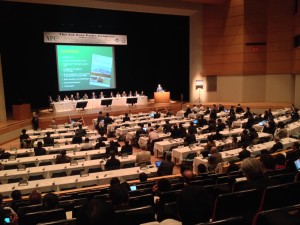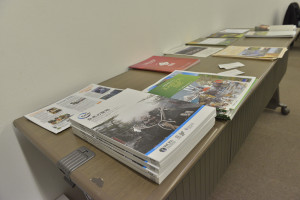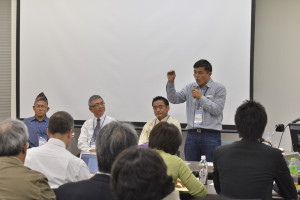
अगोदर निर्देश केलेल्या बाबीसंबंधी बोलताना आशियाई पार्क काँग्रेस (APC), सेंदई शहरात आयोजित, जपान पासून 13 - 18व्या नोव्हेंबर 2013 स्वागत 800 पासून लोक 22 आशियाई देश आणि जगभरातील. सेक्रेड नॅचरल साइट्स इनिशिएटिव्ह आणि डब्ल्यूसीपीए जपानने एक समर्पित वर्किंग ग्रुप सत्र आणि एक साइड इव्हेंट आयोजित केला ज्यामध्ये आशियातील पवित्र नैसर्गिक स्थळांच्या समृद्ध आणि वैविध्यपूर्ण आयामांवर चर्चा केली गेली.. वर्ल्ड पार्क्स काँग्रेसमध्ये पूर्वतयारी इनपुट केले गेले आणि एशियन सेक्रेड नॅचरल साइट्स नेटवर्क स्थापन करण्याच्या दिशेने पावले उचलली गेली.. सेक्रेड नॅचरल साइट्सने एकूणच एपीसीमध्ये उच्च प्रोफाइल प्राप्त केले आणि काँग्रेसच्या निकालांमध्ये लक्षणीय उल्लेख.

“संरक्षित क्षेत्राचे आशियाई तत्वज्ञान” हे प्राध्यापक अमरान हमझा यांच्या मुख्य सादरीकरणाचे शीर्षक होते, एपीसीच्या सुरुवातीच्या सत्रात मलेशियाकडून. स्रोत: खोल Verschuuren.
"आम्ही ओळखतो की आशियामध्ये उद्भवलेल्या अनेक संस्कृती आणि धर्मांना नैसर्गिक वैशिष्ट्ये आणि घटनांबद्दल खूप आदर आहे., आणि स्थानिक समुदायांद्वारे संरक्षित आणि व्यवस्थापित केलेल्या पवित्र नैसर्गिक साइट्स तयार केल्या आहेत. ही विशेष ठिकाणे केवळ लोक आणि समुदायांच्या आध्यात्मिक समृद्धी आणि कल्याणासाठी योगदान देत नाहीत, परंतु जैवविविधता आणि परिसंस्थेच्या सेवांचे संरक्षण करण्यातही मोलाची भूमिका बजावते”. स्रोत: आशियाई संरक्षित क्षेत्रांची सनद.
"संरक्षित क्षेत्रांचे आशियाई तत्वज्ञान” हे प्रोफेसर अमरान हमझा यांच्या मुख्य सादरीकरणाचे शीर्षक होते, एपीसीच्या सुरुवातीच्या सत्रात मलेशियाकडून. जेव्हा त्यांनी निसर्ग आणि मानव यांच्यातील सामंजस्याची ऐतिहासिक आशियाई नीतिमत्ता सादर केली तेव्हा काँग्रेसच्या सर्व सहभागींच्या लक्षांत थेट नैसर्गिक स्थळे आणली.. त्याचे सादरीकरण त्याच्या अभ्यासावर आधारित होते आणि प्रकाशन विषयावर, जे संरक्षित क्षेत्रांच्या सांस्कृतिक आणि आध्यात्मिक मूल्यांवर IUCN स्पेशलिस्ट ग्रुपच्या योगदानावर आधारित आहे.
रॉबर्ट वाईल्ड यांच्या अध्यक्षतेखाली एसएनएसवर कार्यशाळा घेण्यात आली (SNSI) आणि नाओ फुरुता (IUCN जपान). जपानमधील काही प्रतिष्ठित साइट्ससह आठ सादरीकरणे करण्यात आली, नेपाळ, तैवान आणि कंबोडिया. गेल्या वर्षीप्रमाणेच पवित्र नैसर्गिक स्थळांसाठी IUCN युनेस्को मार्गदर्शक तत्त्वे होती जपानी मध्ये अनुवादित. जपानच्या दोन सर्वात पवित्र पर्वतांच्या केस स्टडीद्वारे जपानचे प्रतिनिधित्व केले गेले, Hakusan (माउंट हाकू) आणि फुजिसन (माउंट फुजी). बाजूच्या कार्यक्रमाचे प्रमुख प्रश्न होते:
- संरक्षित क्षेत्रांच्या सांस्कृतिक आणि आध्यात्मिक मूल्यांवर IUCN WCPA विशेषज्ञ गटाच्या सहकार्याने पवित्र नैसर्गिक स्थळांचे आधुनिक महत्त्व आणि संदर्भासह संरक्षित क्षेत्रांचा सराव आणि ऑपरेशन यावर लक्ष केंद्रित केलेले गोषवारा आमंत्रित करतात., उदा. संरक्षित क्षेत्रांच्या सांस्कृतिक आणि आध्यात्मिक मूल्यांवर IUCN WCPA विशेषज्ञ गटाच्या सहकार्याने पवित्र नैसर्गिक स्थळांचे आधुनिक महत्त्व आणि संदर्भासह संरक्षित क्षेत्रांचा सराव आणि ऑपरेशन यावर लक्ष केंद्रित केलेले गोषवारा आमंत्रित करतात., संरक्षित क्षेत्रांच्या सांस्कृतिक आणि आध्यात्मिक मूल्यांवर IUCN WCPA विशेषज्ञ गटाच्या सहकार्याने पवित्र नैसर्गिक स्थळांचे आधुनिक महत्त्व आणि संदर्भासह संरक्षित क्षेत्रांचा सराव आणि ऑपरेशन यावर लक्ष केंद्रित केलेले गोषवारा आमंत्रित करतात.?
- संरक्षित क्षेत्रांसाठी वडिलोपार्जित पवित्र नैसर्गिक स्थळांची आधुनिक प्रासंगिकता काय आहे आणि हे कसे चांगले ओळखले जाऊ शकते आणि पारंपारिक पालकांना कसे गुंतवले जाऊ शकते?
- संरक्षित क्षेत्रांसाठी वडिलोपार्जित पवित्र नैसर्गिक स्थळांची आधुनिक प्रासंगिकता काय आहे आणि हे कसे चांगले ओळखले जाऊ शकते आणि पारंपारिक पालकांना कसे गुंतवले जाऊ शकते, संरक्षित क्षेत्रांसाठी वडिलोपार्जित पवित्र नैसर्गिक स्थळांची आधुनिक प्रासंगिकता काय आहे आणि हे कसे चांगले ओळखले जाऊ शकते आणि पारंपारिक पालकांना कसे गुंतवले जाऊ शकते?
-

जपानी आययूसीएन युनेस्को सेक्रेड नॅचुरल साइट मार्गदर्शक तत्त्वांच्या प्रती ज्या गटात काम चालू होते त्या बाजूला कार्यक्रमात प्रदर्शन. स्रोत: APC
सादरकर्ते सध्या त्यांची सादरीकरणे मध्ये विकसित करत आहेत ऑनलाइन केस स्टडी वर्णन च्या 1000 शब्द तसेच 3000 शब्द लेख जे एशियन सेक्रेड नॅचरल साइट्सवरील प्रकाशनाला बळकट करतील जे वर्ल्ड पार्क्स काँग्रेसमध्ये सादर केले जातील 2014. बोथे, ऑनलाइन केस स्टडी आणि पुस्तक नवीन सबमिशनसाठी खुले आहेत. जर तुम्हाला स्वारस्य असेल तर कृपया संपर्क साधा info@sacrednaturalsites.org.
बाजूचा कार्यक्रम: बास वर्चुरेन यांनी एक साइड इव्हेंट सादरीकरण केले आणि त्यानंतर गट कार्य केले जेथे सहभागींनी तीन मुख्य मुद्द्यांवर चर्चा केली, मध्ये इनपुट वर्किंग ग्रुप 3 परिणाम, WPC मध्ये इनपुट आणि एशियन सेक्रेड नॅचरल साइट्स नेटवर्कची क्षमता.
साईड इव्हेंटमधील सहभागींनी मान्य केले की एशियन सेक्रेड नॅचरल साइट्स नेटवर्क वर्ल्ड पार्क्स काँग्रेससाठी आणि शक्यतो पुढे काम करण्यासाठी खूप उपयुक्त ठरेल.. अनेक संभाव्य मजबूत नातेसंबंध तयार केले गेले आणि सुरुवातीच्या ईमेल गटासह प्रारंभ करण्याचे मान्य केले गेले 40 संपर्क. या नेटवर्कचे उद्दिष्ट आहे की संप्रेषण सुधारणे आणि पवित्र नैसर्गिक स्थळांना ओळखणे आणि संरक्षित क्षेत्रे आणि प्रदेशातील विस्तीर्ण जमीन आणि समुद्रदृश्ये. पुढील वर्षी सिडनी येथील वर्ल्ड पार्क्स काँग्रेसमध्ये पवित्र नैसर्गिक स्थळांना कसे समर्थन द्यायचे यावर देखील ते लक्ष केंद्रित करेल आणि त्यात सहभागी होण्याच्या स्वारस्याने नवीन सदस्यांसाठी खुले आहे. (संपर्क: info@sacrednaturalsites.org).
-

जैलब कुमार राय नेपाळमधील पवित्र नैसर्गिक स्थळे आणि संरक्षित क्षेत्रांची भूमिका मांडत आहेत. पार्श्वभूमीच्या पॅनेलवर इतर काही सत्र सादरकर्ते आहेत; श्री. नेपाळमधील कमलकुमार राय, कंबोडियातील प्रोफेसर यी-चुंग हसू आणि श्री. नेपाळमधील त्सुम व्हॅलीमधील लामा नीमा. स्रोत: APC.
जैवविविधता नेटवर्क जपानच्या मदतीने, सेक्रेड नॅचरल साइट्स इनिशिएटिव्ह प्रायोजित करण्यास सक्षम होते तीन नेपाळींचा संघ एपीसीमध्ये जोरदार उपस्थिती लावेल. दूरस्थ पासून संरक्षक लामा निमा त्सम व्हॅली आणि त्यांचे सहकारी जैलब राय यांचे फॉरेस्ट ऍक्शन नेपाळ कसे सादर केले त्सम व्हॅली शंभर वर्षांपूर्वी पवित्र दरी घोषित करण्यात आली होती. कमलकुमार राय यांनी धर्माची भूमिका मांडली, येथे अध्यात्म आणि सांस्कृतिक मूल्ये लैच पोखरी, एक पवित्र हिमालयीन उंचावरील तलाव आणि प्रमुख तीर्थक्षेत्र. सालपा पोखरीच्या व्यवस्थापन आव्हानांच्या विविधतेने प्रेरित, कमल राय यांनी आता पवित्र नैसर्गिक स्थळांवरील आवश्यक IUCN UNESCO मार्गदर्शक तत्त्वांचे नेपाळी भाषेत भाषांतर हाती घेतले आहे..
जैलाब राय यांनी नेपाळमधील संरक्षित क्षेत्रांमधील पवित्र नैसर्गिक स्थळांच्या भूमिकेवर अतिरिक्त सादरीकरण केले.. त्यांचे सादरीकरण हे केवळ एक उदाहरण होते ज्याने ICCA-कन्सोर्टियम बरोबरचे उत्पादक सहकार्य स्पष्ट केले आणि ICCA कामकाजाच्या सत्रात सादर केलेल्या अनेक केस स्टडीजमध्ये सेक्रेड नॅचरल साइट्स आणि सेक्रेड नॅचरल साइट्स सेशनमध्ये सादर केलेल्या अनेक केसेसमध्ये ICCAs वैशिष्ट्यीकृत होते..
APC नंतर काही दिवसांनी माउंट फुजीच्या अतिशय मनोरंजक सहलीने कालांतराने पवित्राचे वेगवेगळे अर्थ दाखवले.. सुप्रसिद्ध आणि प्रतिष्ठित ज्वालामुखी आणि जपानचे राष्ट्रीय चिन्ह प्राचीन काळापासून शिंटो अनुयायांसाठी त्याच्या विशेष आध्यात्मिक मूल्यांसाठी ओळखले जाते.. श्री. ओनो आणि श्री. यामानाशी इन्स्टिट्यूट ऑफ एन्व्हायर्नमेंटल सायन्सेसच्या होंगोने सहलीतील सहभागींना दाखवले की या शिंटो समजुती बौद्ध धर्माच्या वेगवेगळ्या पट्ट्यांशी कशाप्रकारे जुळल्या आणि याचा पर्वतावर आणि आसपासच्या उपासनेच्या विविध पद्धतींवर कसा परिणाम झाला.. सध्या त्यांचे काम तयार होत असल्याने आम्ही माउंट वर ऑनलाइन केस स्टडी दाखवण्यास सक्षम होऊ अशी आशा आहे. नजीकच्या भविष्यात फुजी.






